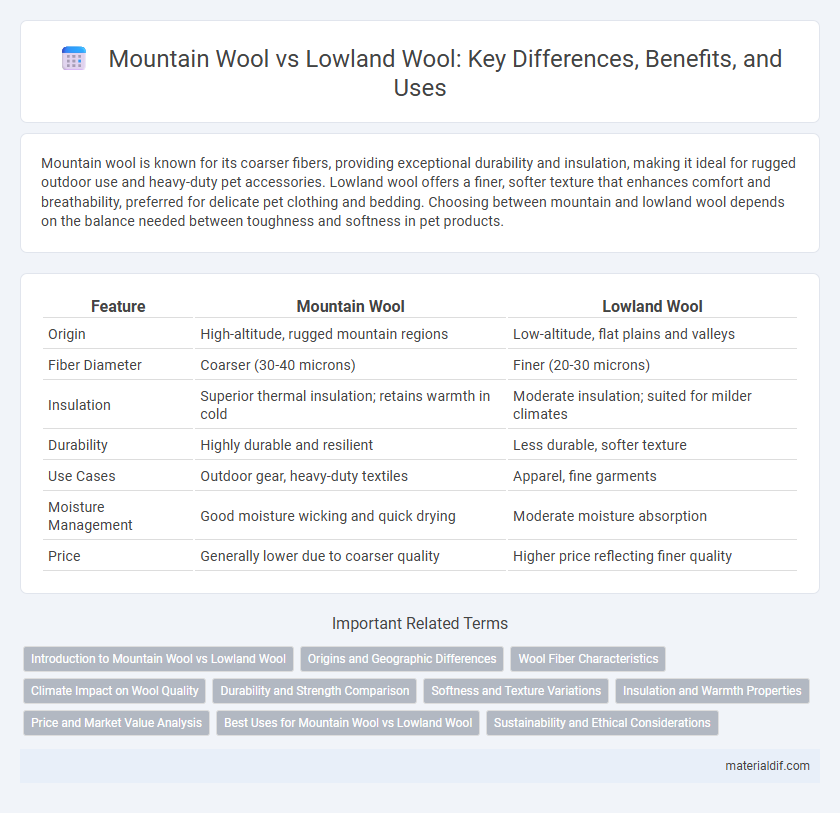Mountain wool is known for its coarser fibers, providing exceptional durability and insulation, making it ideal for rugged outdoor use and heavy-duty pet accessories. Lowland wool offers a finer, softer texture that enhances comfort and breathability, preferred for delicate pet clothing and bedding. Choosing between mountain and lowland wool depends on the balance needed between toughness and softness in pet products.
Table of Comparison
| Feature | Mountain Wool | Lowland Wool |
|---|---|---|
| Origin | High-altitude, rugged mountain regions | Low-altitude, flat plains and valleys |
| Fiber Diameter | Coarser (30-40 microns) | Finer (20-30 microns) |
| Insulation | Superior thermal insulation; retains warmth in cold | Moderate insulation; suited for milder climates |
| Durability | Highly durable and resilient | Less durable, softer texture |
| Use Cases | Outdoor gear, heavy-duty textiles | Apparel, fine garments |
| Moisture Management | Good moisture wicking and quick drying | Moderate moisture absorption |
| Price | Generally lower due to coarser quality | Higher price reflecting finer quality |
Introduction to Mountain Wool vs Lowland Wool
Mountain wool, sourced from sheep raised in high-altitude, harsh climates, is typically coarser, thicker, and more resilient compared to lowland wool. Lowland wool, derived from sheep in milder, low-altitude regions, tends to be finer, softer, and more uniform in fiber quality. These differences in environmental conditions and sheep breeds drive distinct properties and applications for mountain versus lowland wools.
Origins and Geographic Differences
Mountain wool originates from sheep adapted to harsh, elevated environments, resulting in fibers that are coarser and more durable. Lowland wool comes from sheep raised in milder, low-altitude regions, characterized by finer and softer fibers suited for lightweight textiles. Geographic differences in climate and terrain directly influence the fiber's texture, length, and resilience, shaping their distinct uses in textile production.
Wool Fiber Characteristics
Mountain wool fibers are typically coarser, thicker, and have a higher diameter ranging from 30 to 40 microns, providing enhanced durability and insulation suitable for harsher climates. Lowland wool fibers are finer and softer, usually measuring between 20 to 30 microns, offering better elasticity and a smoother texture ideal for high-quality textile production. The crimp and resilience of mountain wool differ, making it more water-resistant, while lowland wool excels in breathability and comfort.
Climate Impact on Wool Quality
Mountain wool, produced in harsh, cold climates, typically exhibits denser fibers and higher resilience, offering superior insulation and durability compared to lowland wool. Lowland wool, grown in milder, temperate environments, tends to have finer, softer fibers but may lack the same strength and weather resistance. Climate influences moisture retention and fiber structure, making mountain wool ideal for extreme weather garments while lowland wool suits lighter, temperate apparel.
Durability and Strength Comparison
Mountain wool exhibits higher durability and tensile strength due to its coarser fibers and greater staple length, making it ideal for heavy-duty textiles and outdoor garments. In contrast, lowland wool has finer, softer fibers with shorter staples that provide excellent insulation and comfort but offer less resistance to wear and tear. The structural differences in fiber thickness and length directly impact the longevity and performance of wool products from these two regions.
Softness and Texture Variations
Mountain wool typically features coarser fibers with a more rugged texture, ideal for durability and insulation in harsh climates. Lowland wool, by contrast, offers finer, softer fibers that create a smoother, more comfortable fabric, favored for garments worn directly against the skin. The variation in softness and texture between mountain and lowland wool results from differences in sheep breeds and environmental conditions affecting fiber growth.
Insulation and Warmth Properties
Mountain wool typically offers superior insulation and warmth properties due to its coarser fibers and higher crimp, which trap more air and retain heat effectively in cold environments. Lowland wool features finer, softer fibers that provide moderate insulation, making it more breathable but less effective in extreme cold. The denser structure of mountain wool enhances thermal regulation, ensuring better protection against harsh weather conditions.
Price and Market Value Analysis
Mountain wool generally commands a higher market price due to its coarser fibers and durability, making it ideal for heavy textiles and outdoor garments. Lowland wool, known for its finer and softer texture, often attracts premium prices in luxury fashion markets but faces stiff competition from synthetic alternatives. Market value analysis reveals that while mountain wool maintains steady demand in niche sectors, lowland wool experiences fluctuating prices influenced by trends in high-end apparel and consumer preferences.
Best Uses for Mountain Wool vs Lowland Wool
Mountain wool, characterized by its coarser fibers and greater durability, excels in producing robust outerwear and heavy-duty textiles suitable for harsh climates. Lowland wool, finer and softer, is ideal for lightweight garments, fine knitwear, and next-to-skin clothing, offering superior comfort and warmth. The distinct fiber properties of mountain and lowland wool determine their optimal applications in industrial and fashion textiles.
Sustainability and Ethical Considerations
Mountain wool, sourced from sheep grazing on rugged, biodiversity-rich terrains, promotes sustainable land use by maintaining natural ecosystems and reducing the need for chemical inputs. Lowland wool production often involves intensive farming practices that may lead to higher environmental impact through increased water usage and soil degradation. Ethically, mountain wool farming typically supports small-scale, locally managed flocks with better animal welfare standards, contrasting with some industrial lowland operations.
Mountain Wool vs Lowland Wool Infographic

 materialdif.com
materialdif.com